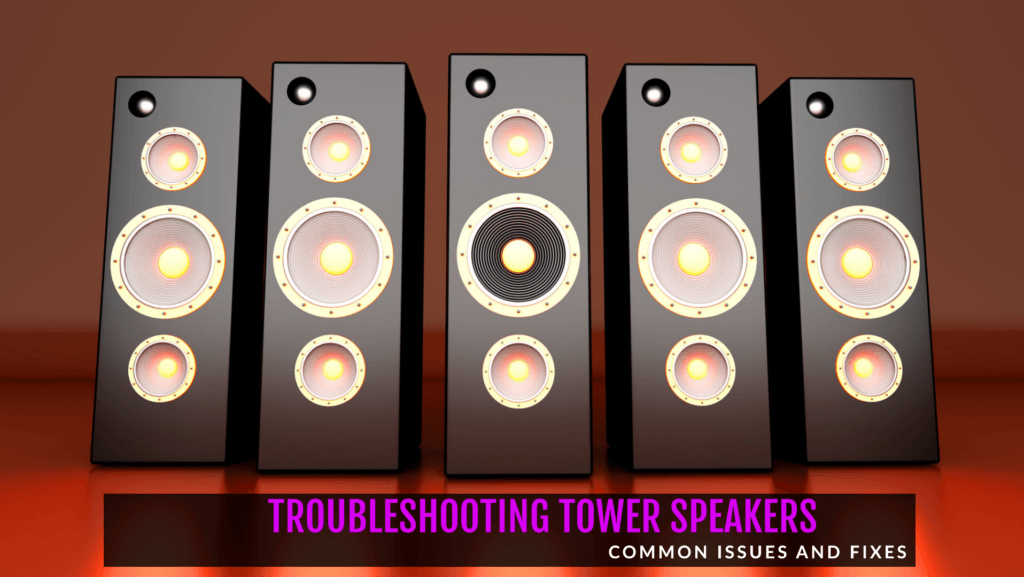Welcome to a Technology Moment, In the realm of audio enthusiasts, few pieces of equipment evoke the blend of elegance and performance quite like tower speakers. These towering pillars of sound not only elevate your listening experience but also serve as a testament to the marriage of cutting-edge technology and timeless design.
Join us as we delve into the world of tower speakers, exploring their evolution, the science behind their superior audio quality, and why they remain a coveted choice for audiophiles and casual listeners alike. Whether you’re a seasoned connoisseur or a curious newcomer, prepare to embark on a journey where innovation meets sonic bliss.
What Are Tower Speakers?
Tower speakers, also known as floor-standing speakers, are a type of loudspeaker that stands vertically on the floor. They are typically tall and narrow, designed to deliver high-fidelity sound across a wide range of frequencies. These speakers are often used in home theater systems, music listening rooms, and living rooms, where they can provide a powerful and immersive audio experience.
The evolution of tower speakers can be traced back to the early days of audio technology. Initially, speakers were bulky and lacked the refined sound quality we enjoy today. As technology advanced, so did speaker design. The 1970s and 1980s saw significant improvements in materials and engineering, leading to the development of more sophisticated and stylish tower speakers. Today, these speakers combine state-of-the-art technology with elegant design, making them a popular choice for audiophiles and casual listeners alike.
Why Choose Tower Speakers?
Tower speakers offer several advantages that make them a preferred choice for many audio enthusiasts:
- Enhanced Sound Quality: Due to their larger size and multiple drivers, tower speakers can produce a fuller and more detailed sound. They often include dedicated drivers for different frequency ranges, such as woofers for bass, mid-range drivers, and tweeters for high frequencies.
- Impressive Aesthetics: Tower speakers are designed not only for performance but also for visual appeal. Their sleek and elegant design can complement any home decor, making them a stylish addition to your living space.
- Versatility: These speakers are versatile and can be used in various audio setups. Whether you’re setting up a home theater system or simply want to enjoy high-quality music, tower speakers can meet your needs.
- Power and Volume: Tower speakers are capable of handling more power and delivering higher volume levels compared to smaller speakers. This makes them ideal for larger rooms and for listeners who enjoy loud and dynamic sound.
Table of Contents
Benefits of Tower Speakers
Superior Sound Quality: One of the primary reasons to choose tower speakers is their superior sound quality. Unlike smaller speakers, tower speakers have larger drivers and more space for acoustic chambers. This allows them to produce a richer, more detailed sound that can fill a room. Whether you are listening to music, watching a movie, or playing a video game, the sound from tower speakers is more immersive and dynamic. The deep bass, clear midrange, and crisp highs ensure that you don’t miss a single note or dialogue.
Aesthetic Appeal: Tower speakers are not just about sound; they also add to the aesthetics of your room. These speakers often come in sleek, stylish designs that can complement any home décor. Available in various finishes and materials, they can be a statement piece in your living room or home theater. The elegant presence of tower speakers can enhance the visual appeal of your space, making it look more sophisticated and high-end.
Versatility in Use: Another significant benefit of tower speakers is their versatility. They are suitable for a wide range of audio applications, from home theaters and music systems to gaming setups. Their robust build and powerful performance make them capable of handling high volumes without distortion. Additionally, many tower speakers come with various connectivity options, including Bluetooth, Wi-Fi, and traditional wired connections, making them compatible with different audio sources and devices.
Key Features to Look For
When shopping for tower speakers, it’s crucial to know what features to prioritize. This ensures you get the best value for your money and an audio experience that meets your needs.
Sound Quality and Frequency Response
Sound Quality: This is arguably the most important aspect of any speaker. High-quality tower speakers should deliver clear, crisp sound across all ranges—bass, midrange, and treble. Look for speakers that produce balanced sound without distortion, even at high volumes.
Frequency Response: This measures the range of frequencies a speaker can reproduce. It’s usually indicated in hertz (Hz), such as 20Hz – 20kHz. A wider frequency response range means the speaker can produce a fuller spectrum of sound, from deep bass to high treble. Pay attention to the lower end of the range if you enjoy bass-heavy music.
Power Handling and Sensitivity
Power Handling: This refers to the amount of power (in watts) a speaker can handle from an amplifier without getting damaged. There are two ratings to consider: RMS (continuous power handling) and peak power handling. RMS is more critical because it indicates the power level the speaker can handle over extended periods. Make sure your amplifier’s power output matches or is slightly lower than the speaker’s RMS rating to avoid damage.
Sensitivity: Sensitivity indicates how efficiently a speaker converts power into sound, measured in decibels (dB). Higher sensitivity means the speaker requires less power to produce the same volume level. For instance, a speaker with 90dB sensitivity will play louder than one with 85dB sensitivity when both are given the same power. If you have a lower-powered amplifier, look for speakers with higher sensitivity ratings.
Build Quality and Materials
Cabinet Construction: The quality of the cabinet housing the speaker components plays a significant role in sound quality. Look for cabinets made from high-density materials like MDF (medium-density fiberboard) rather than cheap plastic, which can vibrate and distort sound. Properly braced and dampened cabinets minimize unwanted resonances and vibrations.
Drivers: These are the components that actually produce sound. Common types include woofers (for bass), midrange drivers, and tweeters (for treble). Materials matter here too—woofers might be made of paper, polypropylene, or even Kevlar, while tweeters could be made of silk, aluminum, or titanium. Each material has its own sound characteristics, so listening tests can help determine what sounds best to you.
Crossover Networks: These electronic circuits inside the speaker ensure that the correct frequencies go to the appropriate drivers. A well-designed crossover can significantly improve sound quality by preventing overlap and ensuring smooth transitions between drivers.
Types of Tower Speakers
When diving into the world of tower speakers, it’s essential to understand the different types available. Let’s break down the various categories of tower speakers:

Passive vs. Active Tower Speakers
Passive Tower Speakers:
- Definition: Passive speakers require an external amplifier or receiver to power them. They do not have a built-in amplifier.
- Advantages: These speakers offer more flexibility in terms of upgrading and customizing your audio setup.
- Disadvantages: They can be more complex to set up due to the need for additional equipment (amplifiers or receivers).
Active Tower Speakers:
- Definition: Active speakers come with built-in amplifiers, meaning they don’t require an external amplifier.
- Advantages: Easier to set up since they only need a power source and an audio input. They are often more compact and can save space.
- Disadvantages: Less flexibility in terms of upgrading, as the amplifier is built into the speaker. If the amplifier fails, the entire speaker might need replacement or repair.
Floorstanding vs. Bookshelf Speakers
Floorstanding (Tower) Speakers:
- Definition: These are large speakers designed to stand on the floor. They are typically tall and can contain multiple drivers (woofers, midrange, and tweeters).
- Advantages: Provide powerful, full-range sound with deep bass and clear highs. They are ideal for larger rooms or home theater setups.
- Disadvantages: They take up more space and are generally more expensive than smaller speakers.
Bookshelf Speakers:
- Definition: Smaller speakers designed to be placed on a shelf, stand, or any elevated surface.
- Advantages: More compact and easier to fit into smaller spaces. They are often more affordable than floorstanding speakers.
- Disadvantages: They might not provide the same depth and fullness of sound as floorstanding speakers, particularly in larger rooms.
Wireless vs. Wired Tower Speakers
Wireless Tower Speakers:
- Definition: These speakers connect to audio sources via Bluetooth, Wi-Fi, or other wireless technologies.
- Advantages: Offer convenience and flexibility in placement since there are no wires to worry about. They are easy to set up and use with modern devices like smartphones and tablets.
- Disadvantages: Wireless speakers can sometimes suffer from connectivity issues or signal interference. They may also require regular battery charging or need to be near a power source.
Wired Tower Speakers:
- Definition: These speakers connect to audio sources via physical cables.
- Advantages: Generally provide a more stable and reliable connection, with no risk of signal dropouts or interference. Often deliver higher sound quality compared to wireless speakers.
- Disadvantages: Limited in terms of placement due to the need for cables. Setting up can be more cumbersome, especially in larger rooms.
Top Brands in the Market
When it comes to tower speakers, choosing a brand known for quality and reliability is crucial. Here’s a detailed look at some of the top brands in the market:
1. Bose
Overview: Bose is a household name in the audio industry, renowned for its innovative technology and high-quality sound. Founded in 1964, Bose has consistently pushed the boundaries of audio performance.
Why Choose Bose?
- Innovative Technology: Bose is known for its proprietary technologies like Waveguide and QuietPort, which enhance sound quality and clarity.
- Design and Aesthetics: Bose speakers often feature sleek, modern designs that can complement any home decor.
- User-Friendly: Bose products are typically easy to set up and use, often featuring smart connectivity options like Bluetooth and Wi-Fi.
Popular Models:
- Bose 901
- Bose 601
- Bose 201
2. Klipsch
Overview: Klipsch has been a leader in the audio world since 1946, known for producing speakers with powerful and dynamic sound. The company prides itself on its horn-loaded technology, which delivers an immersive audio experience.
Why Choose Klipsch?
- Horn-Loaded Technology: Klipsch’s unique horn-loaded speakers provide high efficiency, low distortion, and a dynamic range.
- Robust Build Quality: Klipsch speakers are known for their sturdy construction, ensuring longevity.
- Versatile Range: Klipsch offers a wide range of speakers suitable for various needs, from home theaters to professional setups.
Popular Models:
- Klipsch RP-8000F
- Klipsch R-28PF
- Klipsch Reference Series
3. Sony
Overview: Sony is a global electronics giant, and its audio products reflect the company’s commitment to quality and innovation. Sony’s tower speakers are designed to deliver powerful sound with precision and clarity.
Why Choose Sony?
- Advanced Technology: Sony incorporates cutting-edge technology like High-Resolution Audio and DSEE (Digital Sound Enhancement Engine) into its speakers.
- Stylish Designs: Sony speakers often boast sleek, stylish designs that fit well in any modern home.
- Wide Range of Products: Sony offers a diverse range of speakers, catering to different preferences and budgets.
Popular Models:
- Sony SS-CS3
- Sony SS-HA3
- Sony SS-NA2ES
4. Polk Audio
Overview: Polk Audio has been a trusted name in home audio since 1972. Known for its high-quality, affordable speakers, Polk Audio offers a range of products that deliver excellent performance without breaking the bank.
Why Choose Polk Audio?
- Affordable Quality: Polk Audio provides high-quality speakers at reasonable prices, making them accessible to a wide audience.
- Innovative Design: Polk’s Power Port technology and Dynamic Balance drivers ensure clear, powerful sound.
- Durability: Polk speakers are built to last, with durable materials and robust construction.
Popular Models:
- Polk Audio T50
- Polk Audio Signature Series S60
- Polk Audio RTiA7
5. KEF
Overview: KEF, a British company founded in 1961, is celebrated for its high-end audio products. KEF’s speakers are known for their exceptional sound quality and innovative design.
Why Choose KEF?
- Uni-Q Driver Technology: KEF’s signature Uni-Q driver array delivers a more accurate, three-dimensional sound.
- Premium Build Quality: KEF speakers are made with high-quality materials and precision engineering.
- Award-Winning Sound: KEF speakers frequently receive accolades for their superior sound quality and design.
Popular Models:
- KEF Q950
- KEF R11
- KEF LS50
How to Set Up Tower Speakers
Setting up tower speakers might seem like a daunting task, but with a little patience and the right guidance, you can create a fantastic audio experience.
1. Choose the Right Location
Room Acoustics: The placement of your tower speakers is crucial for optimal sound quality. Consider the acoustics of your room. Soft furnishings, carpets, and curtains can help reduce unwanted echoes and improve sound clarity.
Speaker Placement: Tower speakers should be placed at least a few feet away from the walls to avoid bass buildup. Ideally, they should form an equilateral triangle with your primary listening position, ensuring the speakers are at an equal distance from you and angled slightly inward.
2. Unbox and Inspect
Careful Unboxing: Carefully unbox your tower speakers, ensuring you don’t damage any components. Check for any visible damage during shipping.
Check Contents: Make sure all the necessary cables, manuals, and accessories are included.
3. Connect the Speakers
Identify Connections: Tower speakers typically have binding posts or terminals for connecting speaker wires. These may be color-coded for positive (red) and negative (black) connections.
Use Quality Speaker Wire: Invest in good quality speaker wire to ensure the best sound transmission. Strip the wire ends to expose enough conductor to make a secure connection.
Connect to Receiver: Connect the speaker wire from the positive terminal of your receiver to the positive terminal of the speaker, and do the same for the negative terminals. Ensure a tight connection to prevent any sound loss.
4. Position the Speakers
Symmetrical Setup: Place your speakers symmetrically on either side of your listening area. Use a tape measure to ensure equal distance from your listening position.
Height and Angle: Tower speakers are designed to be tall, but ensure they are at ear level when you’re seated for the best listening experience. Angle them slightly towards your primary listening position for better stereo imaging.
5. Test the Setup
Initial Sound Check: Play some music or a test tone to ensure both speakers are working correctly. Listen for any distortions or imbalances.
Fine-Tuning: Adjust the position and angle of the speakers as needed. Small changes can significantly affect the sound quality, so take your time with this step.
6. Calibrate Your System
Receiver Calibration: Many modern receivers come with automatic calibration systems (like Audyssey, YPAO, or MCACC). Use the included microphone and follow the on-screen instructions to optimize your system for your room.
Manual Adjustments: If you prefer manual adjustments, use a sound meter to balance the speaker levels and ensure the sound is even across all frequencies.
7. Consider Additional Setup Options
Subwoofer Integration: If you have a subwoofer, ensure it is correctly integrated with your tower speakers. Adjust the crossover settings on your receiver to blend the subwoofer seamlessly with your main speakers.
Bi-Wiring or Bi-Amping: Some tower speakers support bi-wiring or bi-amping for improved performance. Check your speaker manual and receiver capabilities to see if these options are available and beneficial for your setup.
8. Enjoy and Maintain
Listen and Enjoy: Once everything is set up, sit back and enjoy the superior sound quality that tower speakers provide. Experiment with different music genres and movie soundtracks to fully appreciate your new setup.
Regular Maintenance: Keep your speakers clean and dust-free.
Common Issues and Troubleshooting

Speaker Distortion
- Problem: Sound is unclear or distorted, especially at higher volumes.
- Causes: Overloading the speaker, poor quality audio source, or damaged speaker components.
- Solutions:
- Check and reduce the volume to avoid overloading.
- Inspect the speaker for physical damage and consider professional repair if necessary.
No Sound from Speakers
- Problem: No audio output from the speakers.
- Causes: Loose or faulty connections, audio source issues, or blown speaker drivers.
- Solutions:
- Check and secure all connections between the speaker and audio source.
- If the speaker drivers are blown, replace them or seek professional repair.
Intermittent Sound
- Problem: Audio cuts in and out intermittently.
- Causes: Loose connections, faulty cables, or interference.
- Solutions:
- Inspect and secure all cables and connections.
- Replace any damaged or faulty cables.
- Ensure there are no electronic devices causing interference near the speakers.
Humming or Buzzing Sound
- Problem: A constant humming or buzzing noise from the speakers.
- Causes: Ground loop issues, electromagnetic interference, or poor shielding.
- Solutions:
- Use a ground loop isolator to eliminate ground loop issues.
- Keep speakers away from other electronic devices that could cause interference.
- Ensure speaker cables are properly shielded.
Poor Bass Response
- Problem: Bass sounds weak or non-existent.
- Causes: Incorrect speaker placement, equalizer settings, or room acoustics.
- Solutions:
- Adjust the placement of the speakers, ensuring they are not too close to walls or corners.
- Check and adjust the equalizer settings on your audio source.
- Consider adding a subwoofer to enhance bass response.
Speaker Crackling
- Problem: Crackling or popping sounds from the speakers.
- Causes: Damaged speaker cones, poor connections, or faulty audio source.
- Solutions:
- Inspect the speaker cones for any visible damage and replace if necessary.
- Test the audio source with another set of speakers to rule out the source as the issue.
Volume Fluctuations
- Problem: The volume level varies without adjustment.
- Causes: Faulty volume control, poor connection, or interference.
- Solutions:
- Check the volume control on the speaker and audio source for any issues.
- Keep speakers and audio source away from devices that could cause interference.
Connectivity Issues (Wireless Speakers)
- Problem: Difficulty connecting to a wireless audio source.
- Causes: Signal interference, out-of-range, or pairing issues.
- Solutions:
- Ensure the speaker is within range of the wireless source.
- Clear any obstacles that could be interfering with the signal.
- Re-pair the speaker with the audio source following the manufacturer’s instructions.
Conclusion
In the conclusion of an article about tower speakers, it’s essential to briefly summarize the main points discussed. This recap helps reinforce the critical aspects for readers and ensures that they leave with a clear understanding of the topic. For example, you might highlight the superior sound quality and aesthetic appeal of tower speakers, the importance of considering key features like sound quality, power handling, and build quality, and the differences between various types such as passive and active speakers.
Reiterate why tower speakers are a worthwhile investment. Emphasize their ability to deliver an immersive audio experience, their stylish designs that can complement any home decor, and their versatility in use, from home theaters to music systems. This part of the conclusion aims to leave readers with a positive impression of tower speakers.
Encourage readers to make informed decisions by considering the features and factors discussed. Mention the importance of researching different brands and models, reading reviews, and possibly even listening to different speakers in person if possible. The goal here is to empower readers with the knowledge they need to choose the right tower speakers for their needs.
FAQs About Tower Speakers
What are the advantages of tower speakers over other types of speakers?
Tower speakers, also known as floorstanding speakers, are designed to deliver superior sound quality with powerful bass and clear highs due to their larger size and multiple drivers. Unlike smaller speakers, they often don’t require a subwoofer to achieve deep bass, making them a great choice for a high-fidelity audio experience. Additionally, their elegant design can enhance the aesthetic of a room.
How do I choose the right tower speakers for my home?
When choosing tower speakers, consider factors such as sound quality, power handling, frequency response, and build quality. Think about your room size and acoustics, as well as your audio preferences. It’s also important to consider whether you need passive or active speakers, and whether you want wired or wireless options. Reading reviews and listening to different models in person can also help in making the right choice.
Are tower speakers suitable for small rooms?
While tower speakers are often favored for their robust sound, they can be suitable for small rooms if chosen carefully. Opt for models with adjustable sound settings or lower power output to prevent overwhelming the space. Some tower speakers are designed to perform well in smaller environments, providing high-quality audio without dominating the room.
Do I need an amplifier for tower speakers?
If you choose passive tower speakers, you will need an external amplifier to power them. Passive speakers do not have built-in amplifiers, so they rely on an external source to drive the audio signal. On the other hand, active tower speakers have built-in amplifiers, so they can be connected directly to your audio source without needing an external amplifier.
Can I use tower speakers for home theater systems?
Yes, tower speakers are an excellent choice for home theater systems. Their ability to produce high-quality sound with deep bass and clear treble makes them ideal for immersive audio experiences in movie watching. Pairing them with a good surround sound setup can enhance the overall cinematic experience.













